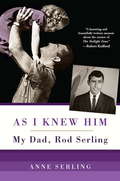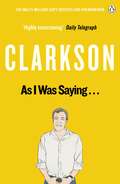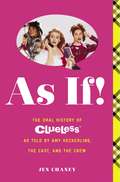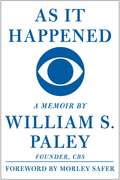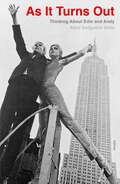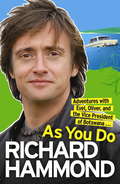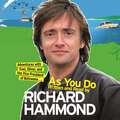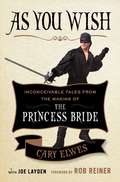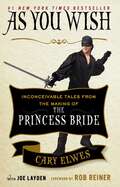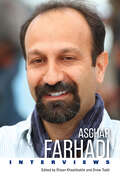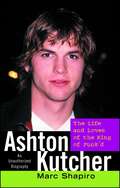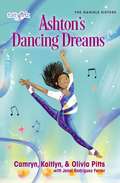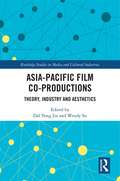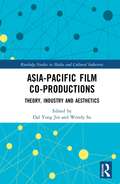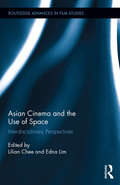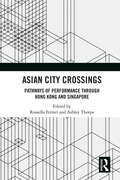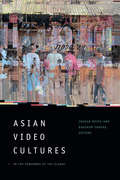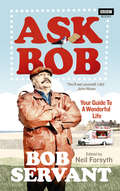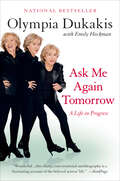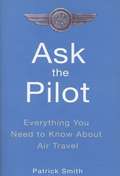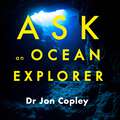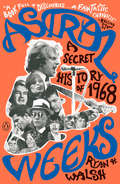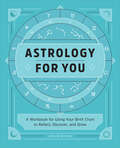- Table View
- List View
As I Knew Him: My Dad, Rod Serling
by Anne SerlingIn Twilight Zone reruns, I search for my father in the man on the screen, but I can't always find him there. Instead, he appears in unexpected ways. Memory summoned by a certain light, a color, a smell -- and I see him again on the porch of our old red lakeside cottage, where I danced on the steps as a child. To Anne Serling, the imposing figure the public saw hosting The Twilight Zone each week, intoning cautionary observations about fate, chance, and humanity, was not the father she knew. Her fun-loving dad would play on the floor with the dogs, had nicknames for everyone in the family, and was apt to put a lampshade on his head and break out in song. He was her best friend, her playmate, and her confidant. After his unexpected death at 50, Anne, just 20, was left stunned. Gradually, she found solace for her grief -- talking to his friends, poring over old correspondence, and recording her childhood memories. Now she shares personal photos, eloquent, revealing letters, and beautifully rendered scenes of his childhood, war years, and their family's time together. Idyllic summers in upstate New York, the years in Los Angeles, and the myriad ways he filled their time with laughter, strength, and endearing silliness -- all are captured here with deep affection and candor. Though begun in loss, Anne's story is a celebration of her extraordinary relationship with her father and the qualities she came to prize through him -- empathy, kindness, and an uncompromising sense of social justice. As I Knew Him is a lyrical, intimate tribute to Rod Serling's legacy as visionary, storyteller, and humanist, and a moving testament to the love between fathers and daughters.
As I Was Saying . . .: The World According to Clarkson Volume 6 (The World According to Clarkson)
by Jeremy ClarksonAs I Was Saying... is the seventh book in Jeremy Clarkson's best-selling The World According to Clarkson series.***Crikey, the world according to Clarkson's been a funny old place of late . . .For a while, Jeremy could be found in his normal position as the tallest man on British television but, more recently, he appears to have been usurped by a pretend elephant.But on paper the real Jeremy remains at the helm. That's as it should be. For nearly thirty years he has been fearlessly leading the charge as one the best comic writers in the country. And in 2015, he shows no sign of slowing down. So, whether it's pondering If Jesus might have been better off being born in New Zealand Why reflexive pronoun abuse is the worst thing in the world How Pam Ayres's head trumps Gordon Gecko's underpants Or what a television presenter with time on his hands gets up toJeremy is still trying to make sense of all the big stuff.Circumstances change. Nothing's forever. But As I Was Saying provides glorious proof that Jeremy remains as funny, puzzled, excitable, outspoken, insightful and thought-provoking as ever. As if you ever doubted it . . .***Praise for Clarkson: 'Brilliant... laugh-out-loud' Daily Telegraph 'Outrageously funny... will have you in stitches' Time Out 'Very funny . . . I cracked up laughing on the tube' Evening Standard
As If!
by Jen ChaneyAcclaimed pop culture journalist Jen Chaney shares an oral history of the cult classic film Clueless in the ultimate written resource about one of the most influential, revered, and enduring movies of the 1990s--in celebration of its twentieth anniversary.Will we ever get tired of watching Cher navigate Beverly Hills high school and discover true love in the movie Clueless? As if! Written by Amy Heckerling and starring Alicia Silverstone, Clueless is an enduring comedy classic that remains one of the most streamed movies on Netflix, Amazon, and iTunes even twenty years after its release. Inspired by Jane Austen's Emma, Clueless is an everlasting pop culture staple. In the first book of its kind, Jen Chaney has compiled an oral history of the making of this iconic film using recollections and insights collected from key cast and crew members involved in the making of this endlessly quotable, ahead-of-its-time production. Get a behind-the-scenes look at how Emma influenced Heckerling to write the script, how the stars were cast into each of their roles, what was involved in creating the costumes, sets, and soundtrack, and much more. This wonderful twentieth anniversary commemoration includes never-before-seen photos, original call sheets, casting notes, and production diary extracts. With supplemental critical insights by the author and other notable movie experts about why Clueless continues to impact pop culture, As If! will leave fans new and old totally buggin' as they understand why this beloved film is timeless.
As It Happened: A Memoir
by William S. PaleyWilliam S. Paley was a founder and chairman of CBS, one of the major television networks in the United States. Under his leadership, CBS introduced the first successful worldwide new broadcast. He fought against radio censorship, particularly in terms of news reporting about World War II. In the 1950s, he promoted Edward R. Murrow to be one of the newscasters for CBS News, starting a news dynasty. He led CBS into television, with CBS leading prime time broadcasting ratings from 1955 through 1976. He was also the owner of the N.Y. Yankees baseball team from 1964 to 1976.
As It Turns Out: Thinking About Edie and Andy
by Alice Sedgwick WohlThe story of the model, actress, and American icon Edie Sedgwick is told by her sister with empathy, insight, and firsthand observations of her meteoric life.As It Turns Out is a family story. Alice Sedgwick Wohl is writing to her brother Bobby, who died in a motorcycle accident in 1965, just before their sister Edie Sedgwick met Andy Warhol. After unexpectedly coming across Edie’s image in a clip from Warhol’s extraordinary film Outer and Inner Space, Wohl was moved to put her inner dialogue with Bobby on the page in an attempt to reconstruct Edie’s life and figure out what made Edie and Andy such iconic figures in American culture. What was it about Andy that enabled him to anticipate so much of contemporary culture? Why did Edie draw attention wherever she went? Who exactly was she, who fascinated Warhol and captured the imagination of a generation? Wohl tells the story as only a sister could, from their childhood on a California ranch and the beginnings of Edie’s lifelong troubles in the world of their parents to her life and relationship with Warhol within the silver walls of the Factory, in the fashionable arenas of New York, and as projected in the various critically acclaimed films he made with her. As Wohl seeks to understand the conjunction of Edie and Andy, she writes with a keen critical eye and careful reflection about their enduring impact. As It Turns Out is a meditation addressed to her brother about their sister, about the girl behind the magnetic image, and about the culture she and Warhol introduced.
As You Do: Adventures With Evel, Oliver, And The Vice-President Of Botswana
by Richard HammondThe life and times of the No.1 bestselling author of ON THE EDGE.The wry, honest and often hilarious chronicles of a very brave and clever TV presenter, Arctic Explorer and general drawer of the Short Straw. As one third of the BBC's Top Gear team, Richard Hammond's year since his near-fatal accident has been full of stunts and drama. From a race to the North Pole (with skis and dog-sled) to a journey through Botswana in a car named Oliver, and a seventeen-mile run through floods to his Gloucestershire home, in order to get to his daughter's birthday party, the year has been eventful, to say the least . . .With his boundless optimism in the face of certain failure, Richard Hammond has become one of our funniest writers about a life (and a job) which constantly present a challenge.
As You Do: Adventures With Evel, Oliver, and The Vice-President Of Botswana
by Richard HammondThe life and times of the No.1 bestselling author of ON THE EDGE.The wry, honest and often hilarious chronicles of a very brave and clever TV presenter, Arctic Explorer and general drawer of the Short Straw. As one third of the BBC's Top Gear team, Richard Hammond's year since his near-fatal accident has been full of stunts and drama. From a race to the North Pole (with skis and dog-sled) to a journey through Botswana in a car named Oliver, and a seventeen-mile run through floods to his Gloucestershire home, in order to get to his daughter's birthday party, the year has been eventful, to say the least . . .With his boundless optimism in the face of certain failure, Richard Hammond has become one of our funniest writers about a life (and a job) which constantly present a challenge.
As You Do: Adventures With Evel, Oliver, and The Vice-President Of Botswana
by Richard HammondThe wry, honest and often hilarious chronicles of a very brave and clever TV presenter, Arctic Explorer and general drawer of the Short Straw. As one third of the BBC's Top Gear team, Richard Hammond's year since his near-fatal accident has been full of stunts and drama. From a race to the North Pole (with skis and dog-sled) to a journey through Botswana in a car named Oliver, and a seventeen-mile run through floods to his Gloucestershire home, in order to get to his daughter's birthday party, the year has been eventful, to say the least . . .With his boundless optimism in the face of certain failure, Richard Hammond has become one of our funniest writers about a life (and a job) which constantly present a challenge.Read by Richard Hammond(p) 2008 Orion Publishing Group
As You Wish: Inconceivable Tales from the Making of The Princess Bride
by Cary ElwesFrom actor Cary Elwes, who played the iconic role of Westley in The Princess Bride, comes a first-person account and behind-the-scenes look at the making of the cult classic film filled with never-before-told stories, exclusive photographs, and interviews with costars Robin Wright, Wallace Shawn, Billy Crystal, Christopher Guest, and Mandy Patinkin, as well as author and screenwriter William Goldman, producer Norman Lear, and director Rob Reiner.The Princess Bride has been a family favorite for close to three decades. Ranked by the American Film Institute as one of the top 100 Greatest Love Stories and by the Writers Guild of America as one of the top 100 screenplays of all time, The Princess Bride will continue to resonate with audiences for years to come.Cary Elwes was inspired to share his memories and give fans an unprecedented look into the creation of the film while participating in the twenty-fifth anniversary cast reunion. In As You Wish he has created an enchanting experience; in addition to never-before seen photos and interviews with his fellow cast mates, there are plenty of set secrets and backstage stories.With a foreword by Rob Reiner and a limited edition original poster by acclaimed artist Shepard Fairey, As You Wish is a must-have for all fans of this beloved film.
As You Wish: Inconceivable Tales from the Making of The Princess Bride
by Joe Layden Cary ElwesFrom actor Cary Elwes, who played the iconic role of Westley in The Princess Bride, comes the New York Times bestselling account of the making of the cult classic film filled with never-before-told stories, exclusive photographs, and interviews with costars Robin Wright, Wallace Shawn, Billy Crystal, Christopher Guest, and Mandy Patinkin, as well as author and screenwriter William Goldman, producer Norman Lear, and director Rob Reiner.The Princess Bride has been a family favorite for close to three decades. Ranked by the American Film Institute as one of the top 100 Greatest Love Stories and by the Writers Guild of America as one of the top 100 screenplays of all time, The Princess Bride will continue to resonate with audiences for years to come. Cary Elwes was inspired to share his memories and give fans an unprecedented look into the creation of the film while participating in the twenty-fifth anniversary cast reunion. In As You Wish he has created an enchanting experience; in addition to never-before seen photos and interviews with his fellow cast mates, there are plenty of set secrets and backstage stories. With a foreword by Rob Reiner and a limited edition original poster by acclaimed artist Shepard Fairey, As You Wish is a must-have for all fans of this beloved film.
Asghar Farhadi: Interviews (Conversations with Filmmakers Series)
by Ehsan Khoshbakht and Drew ToddThe winner of two Academy Awards for Best Foreign Film in only five years, Asghar Farhadi (b. 1972) has become Iran’s most prominent director since the late Abbas Kiarostami. Around the world, especially in the international festival circuit, Farhadi is considered one of the great dramatist filmmakers of his generation. His reputation and influence in his home country is even greater, though also prone to misunderstandings, controversies, and divided critical reception.This volume offers a unique perspective into Farhadi's career in several key respects. Beginning with his work in television, the interviews collected here chart his rise from theater student to Iranian dramatist to celebrated international filmmaker. The majority of the interviews were conducted in Persian and have been translated into English for the first time.In the course of his career, Farhadi has become the new hope for Iran. On both nights of his Oscar wins, Iranians flooded the streets with joy in a rare (and illegal) celebration. Yet, like other contemporary Iranian filmmakers who have struggled to reconcile their national identity with their global repute as international filmmakers, Farhadi is at once feted and under fire by his own government. In addition to making recent films outside Iran, he has taken advantage of his celebrity status to make controversial statements on topics ranging from Donald Trump to poverty and capital punishment in Iran. He even asked Iran’s Judiciary to pardon Jafar Panahi, prompting the government to temporarily withdraw permission to shoot his renowned 2011 film A Separation. Asghar Farhadi: Interviews addresses the important dimensions that characterize contemporary Iranian filmmaking. Together, these interviews shed light on what Farhadi sees as his role and responsibilities as an Iranian filmmaker in a global age.
Ashton Kutcher
by Marc ShapiroYou first dug him on That '70s Show. You daydreamed you'd somehow be part of one of his outrageous hoaxes on Punk'd. And The Butterfly Effect gave you butterflies in your stomach. Now here's the inside scoop on America's most glamorous and adorable goofball-turned-superstar -- a biography of Ashton Kutcher that asks the important questions, like whether he's just one lucky dude or one of the savviest entertainers of his generation. You be the judge. From his humble beginnings in Cedar Rapids, Iowa, to his early days as a model, to how he landed the role of Mike Kelso on the hit sitcom That '70s Show, here is everything you ever wanted to know about Ashton Kutcher. Find out why he studied biomedical engineering in college, why he pretended to end the run of the MTV show in which he'd punk'd his way to the top, and why he's so hellbent on landing dramatic roles. Here's the dish on his family, his outlook on life, his controversial relationship with megastar Demi Moore...and more -- like all the basics: stats, quirky habits, you name it. Featuring fantastic photos and cool quotes, Ashton Kutcher: The Life and Loves of the King of Punk'd -- like Ashton himself -- has it all! It's a must-have for any fan.
Ashton's Dancing Dreams (Faithgirlz / The Daniels Sisters #2)
by Kaitlyn Pitts Camryn Pitts Olivia PittsA new city. A new school. New friends. The Daniels sisters have been slowly rebuilding their lives after their mother’s death. Ansley’s the baker. Amber’s the volleyball player. Ashton "Cammie" Daniels has fallen in love with dancing. There’s nothing she loves better than attending dance class with her two friends, Rani and June. But that joy is in jeopardy when Rani’s father announces they may be moving to London. When she finds out about the school's spring talent show, Ashton thinks that if she and her friends enter and dance, Rani's parents will think twice about taking their daughter away from her home, friends, and activities. But her dreams begin to fall apart when the group can't agree on music, costumes, or choreography! Cammie has an important decision to make: stick it out for Rani's sake, go off on her own, or close the curtain for good on her dream to dance. Ashton’s Dancing Dreams—Is the second book in the Daniels Sisters Faithgirlz fiction seriesFeatures diverse characters any tween girl can relate toWritten by the daughters of beloved author and speaker Wynter PittsIs an engaging read for girls ages 8-12 Includes illustrationsIs a perfect gift for tween girls, and is great for Spring Break and summer vacation reading
Asia-Pacific Film Co-productions: Theory, Industry and Aesthetics (Routledge Studies in Media and Cultural Industries)
by Dal Yong Jin Wendy SuThis book examines cross-regional film collaboration within the Asia-Pacific region. Through a mixed methods approach of political economy and industry, market and textual analysis, the book contributes to the understanding of the global fusion of cultural products and the reconfiguration of geographic, political, economic, and cultural relations. Issues covered include: cultural globalization and Asian regionalization; identity, regionalism, and industry practices and inter-Asian and trans-Pacific co-production practices among the U.S., China, South Korea, Japan, India, Hong Kong, Argentina, Australia, Taiwan, and New Zealand.
Asia-Pacific Film Co-productions: Theory, Industry and Aesthetics (Routledge Studies in Media and Cultural Industries)
by Dal Yong Jin Wendy SuThis book examines cross-regional film collaboration within the Asia-Pacific region. Through a mixed methods approach of political economy, industry and market, as well as textual analysis, the book contributes to the understanding of the global fusion of cultural products and the reconfiguration of geographic, political, economic, and cultural relations. Issues covered include cultural globalization and Asian regionalization; identity, regionalism, and industry practices; and inter-Asian and transpacific co-production practices among the U.S.A., China, South Korea, Japan, India, Hong Kong, Taiwan, Argentina, Australia, and New Zealand.
Asian Cinema and the Use of Space: Interdisciplinary Perspectives (Routledge Advances in Film Studies)
by Edna Lim Lilian CheeAsian cinemas are connected to global networks and participate in producing international film history while at the same time influenced and engaged by spatial, cultural, social and political transformations. This interdisciplinary study forwards a productive pairing of Asian cinemas and space, where space is used as a discursive tool to understand cinemas of Asia. Concentrating on the performative potential of cinematic space in Asian films, the contributors discuss how space (re)constructs forms of identities and meanings across a range of cinematic practices. Cities, landscapes, buildings and interiors actively shape cinematic performances of such identities and their significances. The essays are structured around the spatial themes of ephemeral, imagined and contested spaces. They deal with struggles for identity, belonging, autonomy and mobility within different national and transnational contexts across East, Southeast and parts of South Asia in particular, which are complicated by micropolitics and subcultures, and by the interventions and interests of global lobbies.
Asian City Crossings: Pathways of Performance through Hong Kong and Singapore
by Rossella Ferrari; Ashley ThorpeAsian City Crossings is the first volume to examine the relationship between the city and performance from an Asian perspective. This collection introduces "city as method" as a new conceptual framework for the investigation of practices of city-based performing arts collaboration and city-to-city performance networks across East- and Southeast Asia and beyond. The shared and yet divergent histories of the global cities of Hong Kong and Singapore as postcolonial, multiethnic, multicultural, and multilingual sites, are taken as points of departure to demonstrate how "city as method" facilitates a comparative analytical space that foregrounds in-betweenness and fluid positionalities. It situates inter-Asian relationality and inter-city referencing as centrally significant dynamics in the exploration of the material and ideological conditions of contemporary performance and performance exchange in Asia. This study captures creative dialogue that travels city-based pathways along the Hong Kong-Singapore route, as well as between Hong Kong and Singapore and other cities, through scholarly analyses and practitioner reflections drawn from the fields of theatre, performance, and music. This book combines essays by scholars of Asian studies, theatre studies, ethnomusicology, and human geography with reflective accounts by Hong Kong and Singapore-based performing arts practitioners to highlight the diversity, vibrancy, and complexity of creative projects that destabilise notions of identity, belonging, and nationhood through strategies of collaborative conviviality and transnational mobility across multi-sited networks of cities in Asia. In doing so, this volume fills a considerable gap in global scholarly discourse on performance and the city and on the production and circulation of the performing arts in Asia.
Asian Video Cultures: In the Penumbra of the Global
by Bhaskar Sarkar Joshua NevesThe contributors to this volume theorize Asian video cultures in the context of social movements, market economies, and local popular cultures to complicate notions of the Asian experience of global media. Whether discussing video platforms in Japan and Indonesia, K-pop reception videos, amateur music videos circulated via microSD cards in India, or the censorship of Bollywood films in Nigeria, the essays trace the myriad ways Asian video reshapes media politics and aesthetic practices. While many influential commentators overlook, denounce, and trivialize Asian video, the contributors here show how it belongs to the shifting core of contemporary global media, thereby moving conversations about Asian media beyond static East-West imaginaries, residual Cold War mentalities, triumphalist declarations about resurgent Asias, and budding jingoisms. In so doing, they write Asia's vibrant media practices into the mainstream of global media and cultural theories while challenging and complicating hegemonic ideas about the global as well as digital media. Contributors. Conerly Casey, Jenny Chio, Michelle Cho, Kay Dickinson, Bishnupriya Ghosh, Feng-Mei Heberer, Tzu-hui Celina Hung, Rahul Mukherjee, Joshua Neves, Bhaskar Sarkar, Nishant Shah, Abhigyan Singh, SV Srinivas, Marc Steinberg, Chia-chi Wu, Patricia Zimmerman
Asians on Demand: Mediating Race in Video Art and Activism
by Feng-Mei HebererDoes media representation advance racial justice? While the past decade has witnessed a push for increased diversity in visual media, Asians on Demand grapples with the pressing question of whether representation is enough to advance racial justice. Surveying a contemporary, cutting-edge archive of video works from the Asian diaspora in North America, Europe, and East Asia, this book uncovers the ways that diasporic artists challenge the narrow—and damaging—conceptions of Asian identity pervading mainstream media. Through an engagement with grassroots activist documentaries, experimental video diaries by undocumented and migrant workers, and works by high-profile media artists such as Hito Steyerl and Ming Wong, Feng-Mei Heberer showcases contemporary video productions that trouble the mainstream culture industry&’s insistence on portraying ethnic Asians as congenial to dominant neoliberal values. Undermining the demands placed on Asian subjects to exemplify institutional diversity and individual exceptionalism, this book provides a critical and nuanced set of alternatives to the easily digestible forms generated by online streaming culture and multicultural lip service more broadly. Employing feminist, racial, and queer critiques of the contemporary media landscape, Asians on Demand highlights how the dynamics of Asian representation play out differently in Germany, the United States, Taiwan, and Spain. Rather than accepting the notion that inclusion requires an uncomplicated set of appearances, the works explored in this volume spotlight a staunch resistance to formulating racial identity as an instantly accessible consumer product.
Ask Bob: Your Guide to a Wonderful Life
by Neil ForsythBBC TV and Radio's Bob Servant, self-styled 'hero of Dundee', addresses life's problems for you, and offers practical solutions you won't find anywhere else.
Ask Me Again Tomorrow: A Life in Progress
by Olympia Dukakis Emily HeckmanSomething about Olympia Dukakis just speaks to people. In her signature straight-talk style, she tells the story of her own history and career.Olympia Dukakis, internationally known movie and theater star, was born into a Greek family in Lowell, Massachusetts. As a first generation Greek-American, Olympia “lived in the hyphen” and struggled to reconcile her American desires with her family’s old-world traditions. ASK ME AGAIN TOMORROW tells the story of Olympia’s struggle to find her place as an American, as a woman and as a star. It specifically explores the relationship between Olympia, whose main ambition was to live her life exactly as she wanted, and her mother, who spent a lifetime constrained by a tradition that delegated her to second class. Like Sidney Poitier’s THIS LIFE and THE MEASURE OF A MAN, this is a book that is more than a celebrity memoir. ASK ME AGAIN TOMORROW will speak to many audiences: readers who also experienced America as an adopted country; readers interested in the art of acting; readers interested in autobiography, and particularly to female readers who have struggled with fitting their own aspirations in with the needs of family. It is a book that will endure.
Ask The Pilot: Everything You Need to Know About Air Travel
by Patrick SmithThough we routinely take to the air, for many of us flying remains mystery. Few of us understand the how and why of jetting from New York to London in six hours. How does a plane stay in the air? Can turbulence bring it down? What is windshear? How good are the security checks? Patrick Smith, an airline pilot and author of Salon.com's popular column, "Ask the Pilot," unravels the secrets and tells you all there is to know about the strange and fascinating work of commercial flight. He offers: A nuts and bolts explanation of how planes fly -Insights into safety and security -Straight talk about turbulence, air traffic control, windshear, and crashes -The history, color, and controversy of the world's airlines The awe and oddity of being a pilot The poetry and drama of airplanes, airports, and traveling abroad In a series of frank, often funny explanations and essays, Smith speaks eloquently to our fears and curiosities, incorporating anecdotes, memoir and a life's passion for flight. He tackles our toughest concerns, debunks conspiracy theories and myths, and in a rarely heard voice dares to return a dash of romance and glamour to air travel.
Ask an Ocean Explorer
by Dr Jonathan CopleyHow deep do sharks swim? Have more people been into space then the deep ocean? And what effect are we having on the health of our seas? Ask An Ocean Explorer answers these questions and more!'Our everyday lives are connected to the deep ocean in ways we seldom realise.'In this audiobook is everything you need to know about our oceans, explained in 25 questions. In Ask An Ocean Explorer marine biologist of over 20 years and advisor for the BBC's Blue Planet II, Dr Jon Copley, explains the science and wonder of the deep ocean. Combining untold history of ocean exploration and personal account of what it's like to be a 'bathynaut' diving in a mini-submarine, Ask An Ocean Explorer will bring to light weird and wonderful deep-sea creatures that we find down there and how the oceans and their health is connected to our everyday lives.(P)2019 Hodder & Stoughton Limited
Astral Weeks: A Secret History of 1968
by Ryan H. WalshA mind-expanding dive into a lost chapter of 1968, featuring the famous and forgotten: Van Morrison, folkie-turned-cult-leader Mel Lyman, Timothy Leary, James Brown, and many more Van Morrison's Astral Weeks is an iconic rock album shrouded in legend, a masterpiece that has touched generations of listeners and influenced everyone from Bruce Springsteen to Martin Scorsese. In his first book, acclaimed musician and journalist Ryan H. Walsh unearths the album's fascinating backstory--along with the untold secrets of the time and place that birthed it: Boston 1968.On the 50th anniversary of that tumultuous year, Walsh's book follows a criss-crossing cast of musicians and visionaries, artists and hippie entrepreneurs, from a young Tufts English professor who walks into a job as a host for TV's wildest show (one episode required two sets, each tuned to a different channel) to the mystically inclined owner of radio station WBCN, who believed he was the reincarnation of a scientist from Atlantis. Most penetratingly powerful of all is Mel Lyman, the folk-music star who decided he was God, then controlled the lives of his many followers via acid, astrology, and an underground newspaper called Avatar.A mesmerizing group of boldface names pops to life in Astral Weeks: James Brown quells tensions the night after Martin Luther King, Jr. is assassinated; the real-life crimes of the Boston Strangler come to the movie screen via Tony Curtis; Howard Zinn testifies for Avatar in the courtroom. From life-changing concerts and chilling crimes, to acid experiments and film shoots, Astral Weeks is the secret, wild history of a unique time and place.One of LitHub's 15 Books You Should Read This March
Astrology for You: A Workbook for Using Your Birth Chart to Reflect, Discover, and Grow
by Jessie EcclesExplore your birth chart, answer insightful prompts, and see what the stars say about you! Astrology is a powerful tool that can open you up to greater self-understanding and personal growth. This astrology workbook shows you how to obtain your birth chart and interpret what it says, so you can discover your most deeply-held truths, create focused intentions, and manifest the life you desire. A clear introduction — See your true potential as you learn about the planets, signs, and houses and how they inform your personality, beliefs, relationships, and more. An interactive workbook format —Find space to fill in your birth chart, and use it to complete guided exercises and insightful prompts that offer clarity on what each placement in your chart means for you. Apply astrology to your life —Learn how to use the knowledge from your birth chart to make choices about everything from your career, to where you live, and what you're passionate about. Find answers and achieve your goals with this astrology book .
